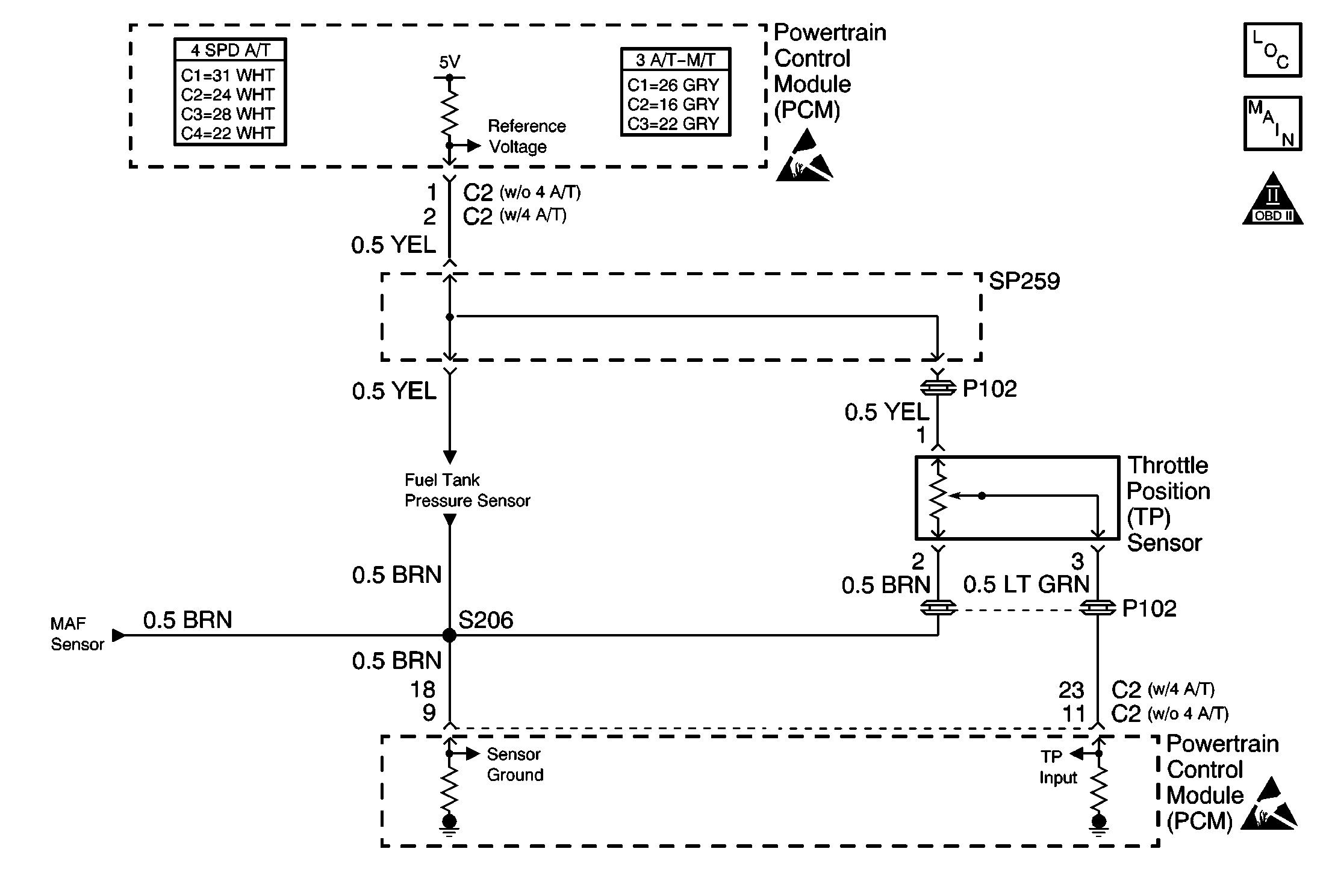
Circuit Description
The throttle position (TP) sensor is a potentiometer whose resistance value changes along with the throttle valve position. The powertrain control module (PCM) provides a 5 volt reference voltage to the TP sensor. The PCM reads the voltage across the TP sensor and uses the voltage to calculate the percentage of throttle valve opening. The TP sensor resistance decreases as the throttle valve opening increases. When the TP sensor resistance decreases the voltage being monitored by the PCM increases. The TP sensor resistance increases when the throttle valve opening decreases, therefore the voltage being monitored by the PCM will decrease.
Conditions for Running the DTC
The ignition is ON.
Conditions for Setting the DTC
The TP sensor input to the PCM is less than 0.1 volts.
OR:
The TP sensor input to the PCM is more than 4.9 volts.
Action Taken When the DTC Sets
| • | The PCM illuminates the malfunction indicator lamp (MIL). |
| • | The PCM stores the conditions that were present when the DTC set as Freeze Frame data. |
| • | The TP sensor angle will default to 0 percent. |
Conditions for Clearing the MIL/DTC
| • | The PCM turns OFF the MIL on the third consecutive trip cycle during which the diagnostic has been run, and the fault condition is no longer present. |
| • | A DTC clears after 40 consecutive warm-up cycles have occurred without a fault. |
| • | A DTC can be cleared by using the scan tool Clear DTC Information function. |
Diagnostic Aids
If DTCs P0110, P0115, and P0120 are also set, the malfunction may be in the sensor ground circuit.
The scan tool will typically display a TP angle of 8-10 percent at idle, and 76-77 percent at wide open throttle (WOT).
An intermittent malfunction may be caused by fault in the TP sensor electrical circuit. Inspect the wiring harness and components for any of the following conditions:
| • | Any backed-out terminals |
| • | Any improper mating of terminals |
| • | Any broken electrical connector locks |
| • | Any improperly formed or damaged terminals |
| • | Any faulty terminal-to-wire connections |
| • | Any physical damage to the wiring harness |
| • | A broken wire inside the insulation |
| • | Any corrosion of the electrical connections, the splices, or the terminals |
Repair any electrical circuit faults that were found. Refer to Wiring Repairs in Wiring Systems.
The information included in the Freeze Frame data can be useful in determining the vehicle operating conditions when the DTC first set.
Test Description
The numbers below refer to the step numbers in the diagnostic table.
-
The OBD System Check prompts the technician to complete some basic checks and store the Freeze Frame data on the scan tool if applicable. This creates an electronic copy of the data taken when the fault occurred. The information is then stored in the scan tool for later reference.
-
This step checks whether the malfunction is a high input condition.
-
This step checks whether the malfunction is a low input condition.
-
This step determines if DTC P0120 is the result of a hard failure or an intermittent condition.
-
The scan tool should read 0 percent , if the reading is more check for a short to battery voltage in the TP sensor input circuit.
-
When the 5 volt reference is jumpered to the TP input circuit, the scan tool parameter should read 100 percent.
-
When the TP sensor input circuit is jumpered to battery voltage , the scan tool parameter should read 100 percent.
Step | Action | Values | Yes | No |
|---|---|---|---|---|
Did you perform the Powertrain On-Board Diagnostic (OBD) System Check? | -- | |||
With the throttle closed, select the TP sensor parameter on the scan tool. Is the TP sensor percentage more than the specified value? | 25% | |||
Monitor the TP sensor with the throttle closed. Is the TP sensor percentage less than the specified value? | 6% | |||
Does DTC P0120 set? | -- | Go to Diagnostic Aids | ||
Is the TP sensor percentage more than the specified value? | 0% | |||
6 | Probe the TP sensor ground circuit on the harness side, using a test lamp connected to battery voltage. Does the test lamp illuminate? | -- | ||
7 |
Was a repair necessary? | -- | ||
8 |
Does the voltage equal the specified value? | 5.0 V | ||
9 | Check for a faulty electrical connection at the TP sensor and the PCM. Replace the terminals if necessary. Was a repair necessary? | -- | ||
10 |
Was a repair necessary? | -- | ||
11 |
Was a repair necessary? | -- | ||
Is the TP sensor percentage more than the specified value? | 90% | |||
Is the TP sensor percentage more than the specified value? | 90% | |||
14 |
Was a repair necessary? | -- | ||
15 |
Was a repair necessary? | -- | ||
16 |
Was a repair necessary? | -- | ||
17 |
Was a repair necessary? | -- | ||
18 |
Was a repair necessary? | -- | ||
19 | Replace the TP sensor. Refer to Throttle Position Sensor Replacement . Is the action complete? | -- | -- | |
20 | Replace the PCM. Refer to Powertrain Control Module Replacement . Is the action complete? | -- | -- | |
21 |
Are any DTCs displayed on scan tool? | -- | System OK |
